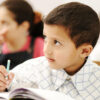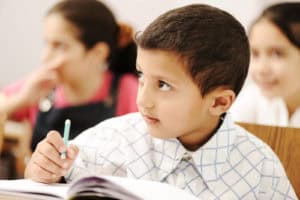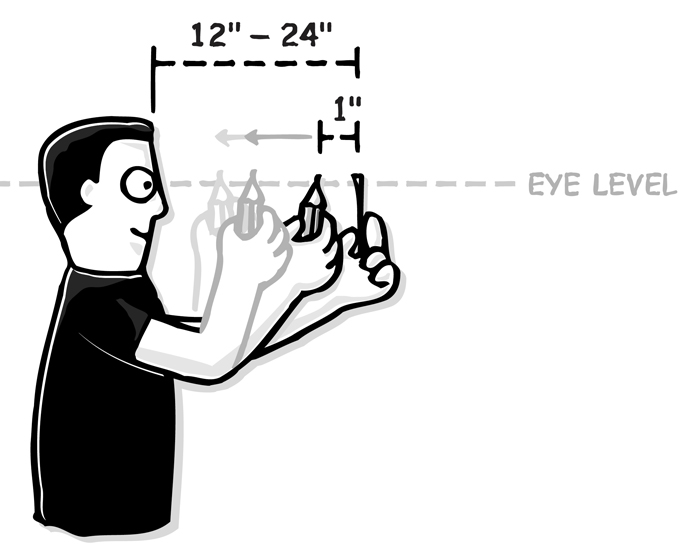
Why Vision Problems Start When School Starts
If your child recently went back to school and suddenly also needed another trip to the eye doctor, you’re not alone. Vision problems often become evident in children right after school starts in the fall. Kindergartners and first graders are often the biggest culprits. This is because these new educational experiences bring new challenges that they haven’t previously experienced at home. For example, a five or six-year-old child may have never needed to read something off the board before, or watch a video from a seat in the back of the classroom. Even learning to write on a piece of paper in front of them can challenge some children.
These issues may seem too small to worry about at first. I mean, what parent of a six-year-old wants to teach them how to take care of a pair of corrective lenses? This added responsibility can also make play more difficult. However, it’s extremely important that kids get corrective eyewear as soon as they need it, as poor vision can significantly impact their academic growth.
So, while it might be a pain to suddenly be alerted to your child’s vision issue right when school starts, in the grand scheme of things, it’s actually a good thing! Today, we’ll discuss the why behind vision problems coming up in school and what you can do to detect and prevent them.
Increased Visual Demands and Common Eye Problems in School Children
 One reason that many children are diagnosed with vision issues when school starts is that the natural progression of a child’s education means that as they get older, school gets more difficult. They’ll be expected to read and write more, and to engage in more cognitively complex tasks. Plus, the size of the text they are expected to read gets smaller as they get older. This, coupled with more close work for longer periods of time, can bring vision issues to light. After all, more people are becoming nearsighted than ever before, and this has a lot to do with increased visual demands from technology.
One reason that many children are diagnosed with vision issues when school starts is that the natural progression of a child’s education means that as they get older, school gets more difficult. They’ll be expected to read and write more, and to engage in more cognitively complex tasks. Plus, the size of the text they are expected to read gets smaller as they get older. This, coupled with more close work for longer periods of time, can bring vision issues to light. After all, more people are becoming nearsighted than ever before, and this has a lot to do with increased visual demands from technology.
Another reason vision problems in school children become more evident in the classroom is that kids have other kids to compare themselves to. Since they are accustomed to their own vision, they might not know that it’s not normal to get headaches while reading or to squint to see the board until their friend doesn’t experience those issues. This can ultimately be a very good thing – it can help your child get the help they need.
Vision Problems and Behavior
Another reason that there may seem to be an increase in vision problems when kids go back to school is that teachers are on high alert, and they are usually in pretty constant communication with parents. Teachers spend much of the first few weeks of school attempting to assess where students are at academically. They may be the first to notice that something is wrong if test scores don’t seem to match cognitive ability.
Vision problems also may creep up unexpectedly because they were previously attributed to something else. For example, there is a strong link between uncorrected poor vision and behavior and mental health problems. Previous teachers may have addressed those issues, overlooking their root cause. Many children are also misdiagnosed with ADHD when it’s actually vision problems causing their behavior.
Teachers may also become aware that their student is having a hard time when reading or completing homework. They may even be having difficulties seeing the board in the front of the classroom. They may also have trouble working on small screens, especially as more and more classrooms move toward electronic instructional materials. The teacher may notice a few things and will then bring the issue up with the parents. This is sometimes how parents discover their child’s vision problem.
School Vision Screenings
Luckily, the link between behavior issues and poor vision is becoming more well-known among teachers. Teachers are learning more about the progression of myopia in school-aged children in their training programs. Many teachers spend much more time reading with their students than their parents do. So, they are often the perfect candidates to detect common eye problems.
Additionally, many schools perform periodic vision screenings on students to detect vision problems. This is actually how a lot of child myopia is diagnosed. If a child fails a school vision screening, teachers or the school nurse usually send a note home to the parents. These screenings are a great starting point for figuring out that something is wrong, but kids often need more testing to receive their official diagnosis and prescription.
Regular Pediatric Eye Exams
Of course, you can avoid a lot of this headache by making sure you keep up with your child’s regular eye exams. As we’ve said many times before, kids should have eye exams done as babies and at one year of age. They should then go to the pediatric eye doctor annually until they reach kindergarten, when they can cut back to every two years if there is no issue. Children who do have vision issues should see their eye doctor annually or as their eye doctor suggests.
Promoting Good Eye Health
No one wants to have poor vision. In fact, having good eyesight at school is one of the keys to success. Of course, good eyesight starts with healthy eyes. Parents can make a big difference in their child’s eye health and vision by ensuring they are getting the proper eye nutrients. Eating a varied, colorful diet is a great place to start. They should also be encouraging their kiddos to play outside more often and limit electronic device use.
Children should also get involved in sports and clubs at school. These are great for exercising their vision as well as meeting new people. And, practice reading and writing with them at home. This allows you to witness their vision problems firsthand. You could even teach them about what healthy vision feels like. Perhaps when they learn what’s normal, they’ll be able to explain to you what’s going on if an issue arises.




My son’s teacher recently noticed that he had difficulties with his eyesight so we went to visit an optician and he now has to wear glasses. He hates them because some of his schoolmates make fun of him so he refuses to wear his glasses. I’m really worried for my little boy especially after seeing these worrying figures http://feelgoodcontacts.com/EyesiteComparison.aspx
Please let me know if there’s anything I can do about this, do you know if there are some natural ways to improve eyesight?